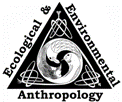Wildlife Damage Management, Internet Center for
Date of this Version
2008
Abstract
Human Behavioral Ecology (HBE) has been used for more than two decades to examine hunter-gatherer societies. Kennett and Winterhalder’s edited volume takes HBE in new directions, applying well-known concepts and models to the transition from foraging to farming. While many edited volumes lack focus, this one is a well-written and cohesive document. Winterhalder and Kennett’s introductory chapter provides a clear summary of HBE literature and a review of common concepts. This makes individual case studies approachable even to HBE newcomers.
The book is not sectioned, but the case studies in Chapters 2 to 12 can be divided based on subject matter. Chapters 2 through 6 (by Tucker, Gremillion, Diehl and Waters, Barlow, and Kennett et al.) constitute one of the most important and substantive discussions in the book. Tucker writes from an ethnographic perspective, while the others examine largely archaeological cases. All five chapters conclude that a mixed foraging-farming economy is often stable for long periods of time. This conclusion is particularly compelling in archaeological circles, as it suggests that the “transition” phase between foraging and farming may actually have been an adaptive mechanism in its own right. Thus, the period spanning any shift from foraging to farming should be examined based on local ecology and historical trajectories, rather than envisioned as a short-term shift between two more successful subsistence strategies. This conclusion may affect the way many archaeologists and anthropologists form research questions about the “transition” between foraging and farming, minimizing problems of oversimplification that have occurred in past discussions of “the Neolithic Revolution”.


Comments
Published in Ecological and Environmental Anthropology Vol. 4, No. 1, 2008. Copyright © 2008 Haywood-Maclin. Used by permission. Online at http://eea.anthro.uga.edu/index.php/eea/index